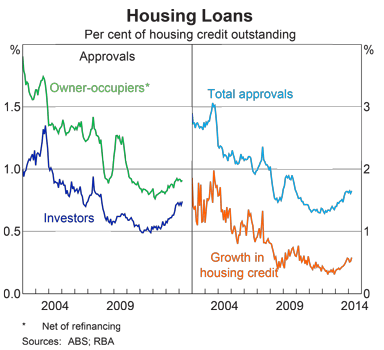I wonder what would happen if the dollar fell to under 70c and all this foreign real estate investment money want to do a runner?
What would happen to the market when overseas investors discovered that their Australian real estate investments have suddenly dropped 30% due to foreign exchange rates.
Enough to trigger a real estate market correction? RBA has sounded the bell.
http://www.smh.com.au/business/mark...ollar-sydney-house-prices-20140703-zsud8.html
Housing Prices
Finally on communication and monetary policy generally, there is the question of housing prices. Few issues seem as capable of sharply dividing opinions as this one. Some use the ‘B’ word, sometimes followed by calls for interest rates to be higher. Others regard it as unthinkable that interest rates would ever respond to housing prices. Still others call for regulatory actions to constrain housing lending, which, by the way, has overall remained quite moderate so far.
The Bank's views on this have been quite consistent. We have made four points.
First, with dwelling prices having fallen between 2010 and 2012, some recovery was not in itself particularly cause for concern, certainly not initially. Moreover, if we think there is a need for higher construction, which we do, an environment of declining prices is probably not conducive to that outcome. Some pick-up in housing prices as a result of lower interest rates was to be expected; it shows that monetary policy is working and is part of the normal transmission process.
Of course, this argument becomes less persuasive if valuations reach new highs and keep rising. So, second, were there to be a further big run-up in prices, with past increases leading to overconfident expectations of continuing gains, it would be a different matter. If this were accompanied by a return to significant increases in household leverage, from already high levels, that would be a matter for concern. It would be adding risk to the system.
But, third, to date the amount of new borrowing does not appear, overall, to be imprudent. The rise in the value of loan approvals over the past year of around 20 per cent is certainly significant. It's important to note, however, that scaled by the amount of credit outstanding, the rate of this flow over recent months, while clearly well off its 2011 low point, is actually not that high compared with longer-run history (Graph 2). It's only a little above 2008 lows, in fact. The growth of credit outstanding for housing is about 6–7 per cent per annum, or slightly above trend nominal income growth. It's hard to mount the soap box to complain about that pace.
Graph 2

Click to view larger
Nonetheless, fourth, investors should take care in the Sydney market, which is the main area where a large increase in borrowing has been occurring. The total value of credit approvals for investor loans in New South Wales as a whole is about 130 per cent higher than in 2008, and it is in the investor segment where there has been evidence of some increase in lending with loan-to-value ratios above 80 per cent in the past couple of quarters.
Here we continue to have two messages.
The first is that in forming expectations about future price gains and deciding their financing structure, people should not assume that prices always rise. They don't; sometimes they fall.
The second is that banks and other lenders need to maintain strong lending standards. APRA has helpfully been reinforcing this point directly with bank boards, as well as stressing the importance of having adequate, higher, interest rate buffers in place, given the current very low level of rates in the market.[7] The maintenance of strong standards will be all the more important given the significant improvement in access to funding via the securitisation market over the past year and the associated increase in competition to lend.
Some segments of the housing market do appear to have been calming down lately. Prices have flattened out in several cities and even in Sydney the pace of increase has lessened.
It remains to be seen whether this slower pace of growth in dwelling prices is temporary or more persistent. It would in my opinion be good, for a range of reasons, if it did persist for a while. If the next couple of years saw an unremarkable performance on prices, and construction staying at the higher levels that will clearly be reached over the coming year, it would be an outcome that would contribute to a balanced growth path for the economy and to housing more people at manageable cost.
Overall, the Bank has not seen developments in the housing market as warranting higher interest rates than the ones we have had, in the current circumstances. This isn't because we think that financial stability considerations should be ignored in the policy decision. On the contrary, they should be, and have been, given due weight, along with all the other factors we have to take into account, in deciding the interest rate path we have chosen. We judge that path to have best balanced, to date, all the various considerations.
- Forums
- Property
- Property Vs Shares
I wonder what would happen if the dollar fell to under 70c and...
-
- There are more pages in this discussion • 48 more messages in this thread...
You’re viewing a single post only. To view the entire thread just sign in or Join Now (FREE)
Featured News
Featured News
The Watchlist
LU7
LITHIUM UNIVERSE LIMITED
Alex Hanly, CEO
Alex Hanly
CEO
SPONSORED BY The Market Online









